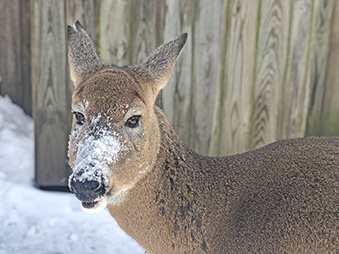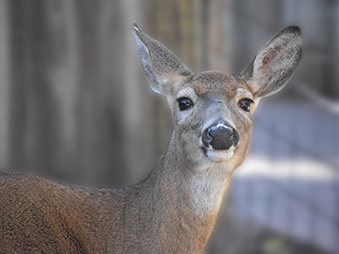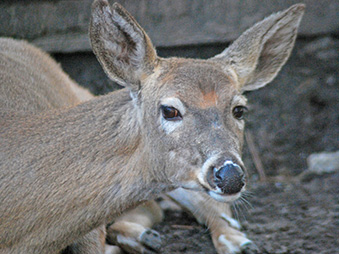Odocoileus virginianus | White-tailed Deer
Name: Melinda (Female)



Meet Melinda, the White-Tailed Deer
Her Story
Say hello to Melinda, a white-tailed deer with a very special story. As a fawn, she was mistakenly believed to be orphaned and was raised by well-meaning people who hoped to return her to the wild. However, because she was raised by humans during a critical stage of development, she became imprinted—meaning she lost her natural fear of humans. Sadly, this made it unsafe for her to live in the wild. Fortunately, Melinda has found a permanent, safe home here at the zoo, where she now serves as a beloved ambassador for her species.
Life in the Wild
White-tailed deer are one of the most widespread and familiar mammals in North and Central America, ranging from southern Canada to Panama. Highly adaptable, they thrive in environments as diverse as forests, grasslands, swamps, deserts, and farmlands.
Built for survival, white-tailed deer rely on speed and agility to escape predators. They can run up to 30 miles per hour, jump over 9-foot-high obstacles, and swim across rivers or lakes when needed. Their most iconic feature—the white underside of their tail—acts like a flag to warn other deer of danger when raised.
Male deer are known as bucks, females as does, and young as fawns. Bucks and does are sexually dimorphic, meaning you can spot visible differences between them. Bucks are typically larger and grow antlers during the breeding season. These antlers are made of bone, grow annually, and are covered in a soft layer called velvet, which nourishes them during growth. As the season ends, the velvet peels away, and bucks rub their antlers on trees to remove it while marking territory.
What’s on the Menu?
In the wild, white-tailed deer are herbivores with diets that shift seasonally. They browse on buds, leaves, grasses, twigs, and even cacti in arid regions. At the zoo, Melinda enjoys a nutritious diet of orchard and timothy hay, alfalfa pellets, Hi-Fiber Wild Herbivore Chow, and a selection of fresh produce to keep her healthy and energized year-round.
Senses and Survival
As prey animals, white-tailed deer have evolved keen senses to detect danger:
- Smell: With around 297 million olfactory receptors, their sense of smell far surpasses ours (humans have about 30 million!). They use scent to detect predators, communicate, and identify food sources.
- Hearing: Deer can hear frequencies up to 54,000 hertz, compared to the human limit of about 20,000. Their large, mobile ears can rotate independently, allowing them to pinpoint the direction of sounds.
- Sight: While their daytime vision is not exceptional—particularly for long distances—they can see nearly 300 degrees around them and excel in low-light conditions thanks to a special membrane in their eyes called the tapetum lucidum, which enhances night vision.
White-tailed deer are crepuscular, meaning they are most active at dawn and dusk.
Ecosystem Influencers
White-tailed deer are more than just a familiar sight—they play a major role in shaping their ecosystems. As a key food source for both predators and humans, they also influence vegetation through their grazing habits. In areas with high deer populations, they can over browse and prevent young trees from growing, which can impact forest regeneration. This is why responsible population management is crucial for maintaining ecological balance.
Not a Pet: Why Fawns Should Be Left Alone
Each spring and summer, it’s common to find fawns lying quietly in tall grass or hidden in quiet yards. But this doesn’t mean they’ve been abandoned. Mother deer often leave their young hidden during the day to avoid attracting predators and only return a few times to nurse.
While it may seem kind to help, “rescuing” a fawn can do more harm than good. Imprinted deer like Melinda often lose their natural instincts, putting them at risk of injury, starvation, or even euthanasia if they become too accustomed to humans.
The best action? Keep your distance and call a licensed wildlife rehabilitator if you believe the fawn is truly orphaned or injured. By sharing Melinda’s story, we hope to raise awareness about the importance of letting wildlife stay wild—even when our intentions are good.
Fact Sheet
Taxonomy
Genus: Odocoileus | Species: virginianus
Kingdom: Animalia | Phylum: Chordata | Class: Mammalia | Order: Artiodactyla | Family: Cervidae |
Favorite Enrichment Type
Browse (bamboo and mulberry), puzzle balls/feeders, and socializing with her keepers!
What I Sound Like
Diet
- In the Wild: Buds, twigs, shrubs, and cacti, along with conifers when food is scarce.
- At the Zoo: Orchard grass and timothy hay, alfalfa pellets, Hi-fiber wild herbivore chow, and fresh produce.
Geographic Range
North and Central America, from southern Canada to Panama.
Habitat
White-tailed deer inhabit a variety of environments, from dense forests and swamps to deserts and farmlands.
Quick Deer Facts
- White-tailed deer can jump over 9 feet high and run up to 30 mph.
- Their sense of smell is nearly 10 times stronger than a human’s.
- They can hear sounds up to 54,000 Hz—nearly three times the human limit.
- White-tailed deer are crepuscular, most active at dawn and dusk.
- Bucks grow new antlers each year, which are used for defense and display.
- Fawns found alone are rarely abandoned—don’t pick them up!
Status: Least Concern
International Union for Conservation of Nature (IUCN) – Least Concern
How to Find Me
Melinda can be found in the Forgotten Forest, to the right of the red-tailed hawk and barred owl. Take a second to hang out with her as she interacts with her enrichment and snoozes in the sunlight.
